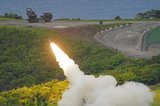AAI conducts successful shipboard trials of the Aerosonde Mark 4.7 small UAS
AAI Corporation announced today that its Aerosonde Mark 4.7 small unmanned aircraft system (SUAS) successfully completed a week of flight operations aboard the Office of the Secretary of Defense’s M-80 Stiletto Maritime Demonstration Test Bed.
AAI conducted a series of Aerosonde Mark 4.7 SUAS flight tests at sea, concluding with multiple successful launches and recoveries aboard the Stiletto vessel.
The Stiletto shipboard trials established AAI’s unique, integrated launch and recovery system at technology readiness level (TRL) 7 during multiple successful aircraft recoveries in a maritime operational environment.
The shipboard Aerosonde Mark 4.7 SUAS includes the integrated launch and recovery system; the Mark 4.7 aircraft with enhanced, leading-edge wings; on-the-move navigation; automatic takeoff and landing capability; and shipboard integration to the command and control center. AAI’s integrated, one-piece launch and recovery system easily fits aboard small ships without necessitating shipboard alterations.
In fact, the Aerosonde Mark 4.7 SUAS has a streamlined, expeditionary footprint that requires a minimum crew and amount of equipment overall. The Aerosonde Mark 4.7, AAI’s entry for the joint US Navy and Marine Corps Small Tactical Unmanned Aircraft System (STUAS)/Tier II competition, was designed to operate from confined areas on land and at sea.
The system delivers unsurpassed multi-mission capability to meet warfighter requirements. A single Aerosonde Mark 4.7 aircraft provides both long-endurance intelligence, surveillance and reconnaissance using its combined electro-optic/infrared payload, as well as simultaneous beyond-line-of-sight communications relay.
“Our Aerosonde Mark 4.7 SUAS delivers powerful benefits for the maritime services including long endurance and unmatched multiple-payload flexibility with superior video and communication relay capabilities,” says AAI Division Vice President, Small Unmanned Aircraft Systems Stephen Flach. “In addition, its single-piece launch and recovery system enables the aircraft to execute missions from even the smallest ships.”
“We have been able to leverage our years of experience designing, manufacturing, fielding, operating and supporting unmanned aircraft systems to develop a highly adaptive system suitable for multiple mission profiles,” says AAI Vice President of Unmanned Aircraft Systems Steven Reid. “Our Aerosonde Mark 4.7 SUAS provides immense capability with the logistical and operational flexibility of an expeditionary footprint.”
More from Uncrewed Vehicles
-
![What's next for the Pentagon after the Replicator programme?]()
What's next for the Pentagon after the Replicator programme?
Although the Replicator initiative has made several accomplishments, there are still multiple gaps to plug across the US Department of Defense (DoD) and its services.
-
![Cummings Aerospace showcases Hellhound loitering munition designed for US Army’s LASSO programme (video)]()
Cummings Aerospace showcases Hellhound loitering munition designed for US Army’s LASSO programme (video)
Cummings Aerospace presented its turbojet-powered Hellhound loitering munition at SOF Week 2025, offering a man-portable solution aligned with the US Army’s LASSO requirements.
-
![SOF Week 2025: PDW unveils attritable FPV drone for SOF operations at scale]()
SOF Week 2025: PDW unveils attritable FPV drone for SOF operations at scale
PDW has revealed its Attritable Multirotor First Person View drone at SOF Week 2025, offering special operations forces a low-cost, rapidly deployable platform for strike and ISR missions, inspired by battlefield lessons from Ukraine.
-
![SOF Week 2025: Teledyne FLIR white paper provides guidance on reusable loitering munitions]()
SOF Week 2025: Teledyne FLIR white paper provides guidance on reusable loitering munitions
Teledyne FLIR is highlighting the emerging requirements for 'recoverable and re-usable' loitering munitions across the contemporary operating environment during this week’s SOF Week conference in Tampa, Florida.
-
![SOF Week 2025: Kraken Technology group debuts K3 Scout USV in North America]()
SOF Week 2025: Kraken Technology group debuts K3 Scout USV in North America
High-performance maritime industry player Kraken Technology Group, based in the UK, has used the SOF Week conference in Tampa, Florida this week to debut its K3 Scout uncrewed surface vessel (USV) to the North American market.
-
![Palladyne AI and Red Cat to demonstrate capabilities for autonomous drone swarms to the US military]()
Palladyne AI and Red Cat to demonstrate capabilities for autonomous drone swarms to the US military
Red Cat and Palladyne AI recently conducted a cross-platform collaborative flight involving three diverse heterogeneous drones.

























